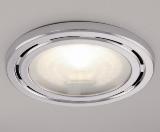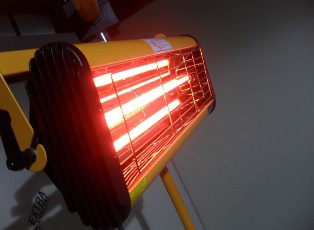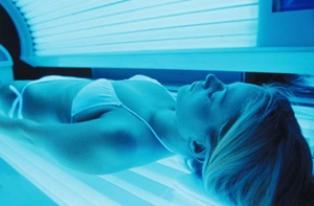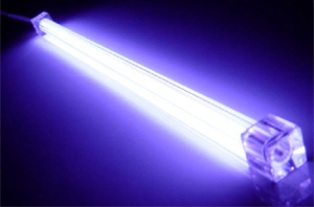Properties and applications of the rays of the optical spectrum
 According to the principles of generation electromagnetic radiation is divided into the following types: gamma radiation, X-ray, synchrotron, radio and optical radiation.
According to the principles of generation electromagnetic radiation is divided into the following types: gamma radiation, X-ray, synchrotron, radio and optical radiation.
The entire range of optical radiation is divided into three regions: ultraviolet (UV), visible and infrared (IR). The range of ultraviolet radiation, in turn, is divided into UV-A (315-400 nm), UV-B (280-315) and UV-C (100-280 nm). Ultraviolet gamma radiation in the region with wavelengths less than 180 nm is often referred to as a vacuum because air in this region of the spectrum is opaque. Radiation that can cause a visual sensation is called visible. Visible radiation is a narrow spectral range (380-760 nm) of optical radiation, corresponding to the sensitivity range of the human eye.
The radiation that can directly cause visual sensation is visible. The limits of the range of visible radiation are conditionally accepted as follows: the lower 380 — 400 nm, the upper 760 — 780 nm.
Emission from this range is used to create the required level of illumination in industrial, administrative and domestic premises.The required level is determined by visibility conditions. In this case, the energy aspect of the irradiation process is less important.

However, for example, in the same agricultural production, light is used not only as a means of illumination. In artificial irradiation of plants, for example in greenhouses, the visible radiation of the irradiating installations is the only source of energy that is stored in the plant in the process of photosynthesis and then used by humans and animals. Here, irradiation is an energetic process.
The effect of visible radiation on animals and birds has not yet been sufficiently studied, but it has been established that its effect on productivity depends not only on the level of illumination, but also on the length of the light period per day, the alternation of light and dark periods, etc. .
Infrared radiation in the spectrum covers the region from 760 nm to 1 mm and is divided into IR-A (760-1400 nm), IR-B (1400-3000 nm) and IR-C (3000-106 nm).
Currently, infrared radiation is widely used for heating buildings and structures, which is why it is often called thermal radiation. It is also used for drying paints. In agriculture, infrared radiation is also widely used for drying vegetables and fruits, heating young animals.

There are special devices for night vision - thermal imagers. In these devices, the infrared radiation of any object is converted into visible radiation. The infrared image shows a picture of the distribution of the temperature fields.

The range of infrared radiation starts from the upper limit of visible light (780 nm) and ends conventionally at a wavelength of 1 mm. Infrared rays are invisible, meaning they cannot cause visual sensation.
The main property of infrared rays is thermal action: when infrared rays are absorbed, bodies heat up. Therefore, they are mainly used for heating various objects and materials and for drying.
When irradiating plants, it should be borne in mind that an excess of infrared rays can lead to excessive overheating and death of plants.

Irradiation of animals with infrared rays improves their general development, metabolism, blood circulation, reduces susceptibility to diseases, etc. The most effective rays of the IR zone. They have the best penetrating ability in the tissues of the body. An excess of infrared rays leads to overheating and death of the cells of living tissues (at temperatures above 43.5 ° C). This circumstance is used, for example, to disinfect grain. During irradiation, the pests of the barn are heated much stronger than the grain and die.
For more details see here: Exports and installations for infrared heating animals
Ultraviolet radiation covers the wavelength range from 400 to 1 nm. In the interval between 100 and 400 nm, three zones are distinguished: UV -A (315 — 400 nm), UV -B (280 — 315 nm), UV -C (100 — 280 nm). The beams of these areas have different properties and therefore find different applications. Ultraviolet radiation is also invisible, but dangerous to vision. Ultraviolet radiation with a wavelength shorter than 295 nm has a suppressive effect on plants, therefore, when it is artificially irradiated, it must be excluded from the general flow of the source.

UV-A radiation can, when irradiated, cause certain substances to glow. This shine is called photoluminescence or simply fluorescence.
Luminescence is called the spontaneous glow of bodies with a duration exceeding the period of light oscillations and excited at the expense of any type of energy, except for heat. Solids, liquids and gases can luminesce. With different methods of excitation and depending on the aggregate state of the body, during luminescence they can undergo different processes.
The rays of this zone are used for luminescence analysis of the chemical composition of certain substances, evaluation of the biological state of the products (germination and damage of the grain, the degree of rotting of potatoes, etc.) and in other cases when a substance can glow with a visible light in a stream of ultraviolet rays.

Radiation from the UV-B zone has a strong biological effect on animals. During irradiation, provitamin D is converted into vitamin D, which facilitates the absorption of phosphorus-calcium compounds by the body. The strength of the bones of the skeleton depends on the degree of absorption of calcium, which is why UV-B radiation is used as an anti-rickets agent for young animals and birds.
The same part of the spectrum has the ability to have the greatest erythema effect, that is, it can cause prolonged reddening of the skin (erythema). Erythema is a consequence of the expansion of blood vessels, which leads to other favorable reactions in the body.
Ultraviolet radiation of the UV-C zone is capable of killing bacteria, that is, it has a bactericidal effect and is used to disinfect water, containers, air, etc.

